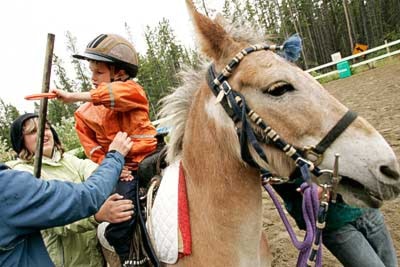Trainer Cathy Rogers squinted to try to read the face of the emotional woman watching from behind the fence.
“What’s up with your mom,” she asked the young boy saddled on the horse she was leading through the open arena.
“Is she happy or upset?”
The young boy didn’t answer.
Instead, he smiled away, thrilled at the experience of riding a horse for the first time.
And this is what caused the woman to weep for joy — she had never seen her special needs child so engaged and so happy.
This is just one of the many successes experienced at Freedom Trails, a therapeutic horse-riding program located in the Pilot Mountain subdivision outside of Whitehorse.
On a recent cold drizzly day, Rogers was working with brothers Logan and Jesse Kalnicki.
She looked the part of a wrangler, wearing a black fringe-leather jacket with matching cowboy hat as she led the boys through an obstacle course of pylons and barrels.
A giant mirror stuck out on one side, allowing the boys to check themselves out as they rode past.
While riding they also completed a number of activities, such as spotting toy horses and cars hidden throughout the riding arena and placing rings onto poles as they passed.
After each activity, Logan gave Rogers and two volunteers a round of high fives.
Six-year-old Logan is autistic and has been riding for four years now.
“It really seems to work for Logan,” his father Darrell Kalnicki said as he watched his sons ride.
“And I’ve talked to other parents who all seem to think that their children really benefit from it.”
Judy Fortin began Freedom Trails 13 years ago after visiting a therapeutic riding stable while on a trip to Juneau.
Originally, Fortin only planned to work with about 20 riders.
Now, thanks to additional trainers like Rogers, she has more than 70 children who participate in the program.
As many as 10 new riders signed up this year alone.
The riders cover a whole range of age and ability.
Some of the more experienced participants practice trick riding — kneeling, standing and even doing shoulder stands while riding.
Logan has been riding for four years now — since he was just two-years-old — but isn’t doing tricks quite yet.
“Sensory deprivation is an issue for him, so the actual movement allows him to focus more on some of the cognitive tasks they have him do,” said Kalnicki.
“It just seems to help him focus on the task at hand and attend to what they’re asking him to do.”
Horseback riding can provide a whole range of sensations, which are beneficial to special-needs children.
But the motion, feel, smell, sound and sight of the horse can be a lot to take in all at once.
Some of the children are apprehensive about being perched on a horse at first.
But they quickly learn to love it.
“I thought this would be nice, to get back and help with the little people, and get back around horses again,” said Jim Tiedeman, a retired RCMP officer who volunteers at Freedom Trails.
“It’s great watching their confidence building.”
However, volunteers like Tiedeman are becoming hard to find, said Fortin.
“For maybe about two years in a row we’ve been down in volunteer.”
And the program is extremely volunteer intensive.
Each rider requires two volunteers who walk on either side of the horse and provide encouragement during the activity.
And a certified horse trainer, like Fortin and Rogers, is also required to teach riding techniques.
Volunteers could work a minimum of one hour a week for the 10 weeks that the program runs.
Many of the current volunteers do much more.
Some of the volunteers end up spending the night out at the Freedom Trails Ranch so that they can work the next day.
Horseback riding was used therapeutically as far back as 600 BC.
After the First World War, many injured soldiers were prescribed riding therapy to deal with both physical and psychological damage.
The technique is now used for a range of disabilities and disorders — including autism, brain damage, Down syndrome and Attention Deficit.
Obviously, it’s not just special needs children that enjoy the experience.
Logan and his little mule Pal, shared the arena with his brother Jesse who rode an old Yukon horse named Sassy.
Jesse’s face lit up into when he was able to brake into a trot at the end of his 45-minute run.
“It’s mostly a sibling thing,” said Kalnicki.
“There are so many programs and so many people dealing with the special needs child that the sibling gets a sense of being left out.”
So, four-year-old Jesse gets to tag along.
“I think it also helps Logan too, because he just enjoys spending time with his brother.”
